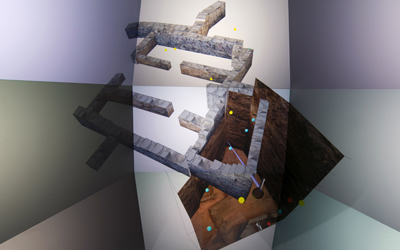3D Virtual Reality Environment Developed at UC San Diego Helps Scientists Innovate
|
The StarCAVE is a five-sided virtual reality (VR) room where scientific models and animations are projected in stereo on 360-degree screens surrounding the viewer, and onto the floor as well. It was constructed by the UC San Diego division of the California Institute for Telecommunications and Information Technology (Calit2). At less than $1 million, the StarCAVE immersive environment cost approximately the same as earlier VR systems, while offering much higher resolution and contrast.
"When you're inside the StarCAVE the quality of the image is stunning," said Thomas A. DeFanti, director of visualization at Calit2 and one of the pioneers of VR systems. "The StarCAVE supports 20/40 vision and the images are very high contrast, thanks to the room's unique shape and special screens that allow viewers to use 3D polarizing glasses. You can fly over a strand of DNA and look in front, behind and below you, or navigate through the superstructure of a building to detect where damage from an earthquake may have occurred."
|
The StarCAVE represents the third generation of surround-VR rooms. DeFanti's team built and named the original Cave Automated Virtual Environment (CAVE) at the University of Illinois at Chicago in 1991. A second-generation model built ten years later at EVL is now the standard surround-VR technology and is widely used around the world and marketed by Mechdyne Corp. The first- and second-generation CAVEs require viewers to wear battery-powered 'shutter' glasses; the StarCAVE provides an improved 3D experience and allows viewers to wear only lightweight, polarized 'sun' glasses.
|
Because the StarCAVE is designed to help scientists, DeFanti and his team made sure to incorporate the latest in computer graphics processing - using 34 of the newest nVIDIA chips that can generate highly complex images. Thirty-four high-definition projectors (two per screen) create very bright left and right eye visuals, i.e. stereo or 3D, per screen. Each pair of projectors is powered by a high-end, quad-core PC running on Linux, with dual graphics processing units and dual network cards to achieve gigabit Ethernet or 10GigE networking.
"With its advanced networking, the StarCAVE is the best virtual-reality portal within the OptIPuter network," said Calit2's DeFanti, co-principal investigator on the National Science Foundation-funded OptIPuter project. "That network now connects more than 20 so-called OptIPortals which are up and running around the world. They are ultra-high-resolution, tiled display walls, but for some researchers, flat display walls just aren't enough: they want the realism that comes from the fully immersive 3D experience that only a 360-degree VR room such as the StarCAVE can offer."
|
Users of the StarCAVE can interact with the visuals on the 360-degree display - by pointing a "wand" that makes it easy to fly through the 3D images and zoom in or out. The exact position of the wand and the user is determined by a multi-camera wireless tracking system.
Among the VR room's other features, it is wheelchair accessible, and it was designed to withstand earthquakes. One of the StarCAVE's five walls (along with its six projectors, three screens and three computers) rolls back on steel rails to provide access for users into the space, and the wall rolls back into place to provide the full 360-degree, immersive VR experience.
While the StarCAVE was in development, computer scientists were working on new applications to adapt computer programs for display in the VR environment. The room connects to the Protein Data Bank, so users can pull up one or multiple proteins and fly around them to find similarities and differences between the proteins. A virtual replica of Calit2's headquarters building at UC San Diego, Atkinson Hall, has been used by neuroscientists who want to know if the human brain operates differently in virtual reality versus reality in 'wayfinding' situations.
"We also created an application which displays computer-aided design models of parts of the new San Francisco Oakland Bay Bridge," said DeFanti. "The application allows users to walk/fly through these parts at their real size, to find material clashes, construction errors, and generally to draw conclusions about whether the structure could be built as designed."
While the StarCAVE is already being used by a variety of scientists at UC San Diego, Calit2 will continue to make upgrades to the system to provide even greater realism for users. Eventually the engineers hope to increase the visual acuity from 20/40 to 20/20, by upgrading the system's 34 projectors from 2K to 4K (roughly 4,000 horizontal pixels for each of the 17 screens) - an upgrade that could cost at least $3 million at today's prices.
Publication
“TheStarCAVE, a third-generation CAVE and virtual reality OptIPortal”
Future Generation Computer Systems, Elsevier, by Thomas A. DeFanti, Gregory Dawe, Daniel J. Sandin, Jurgen P. Schulze, Peter Otto, Javier Girado, Falko Kuester, Larry Smarr, Ramesh Rao.PDF
Related Links
Future Generation Computer Systems Article
Media Contacts
Doug Ramsey, 619-379-2912, dramsey@ucsd.edu




